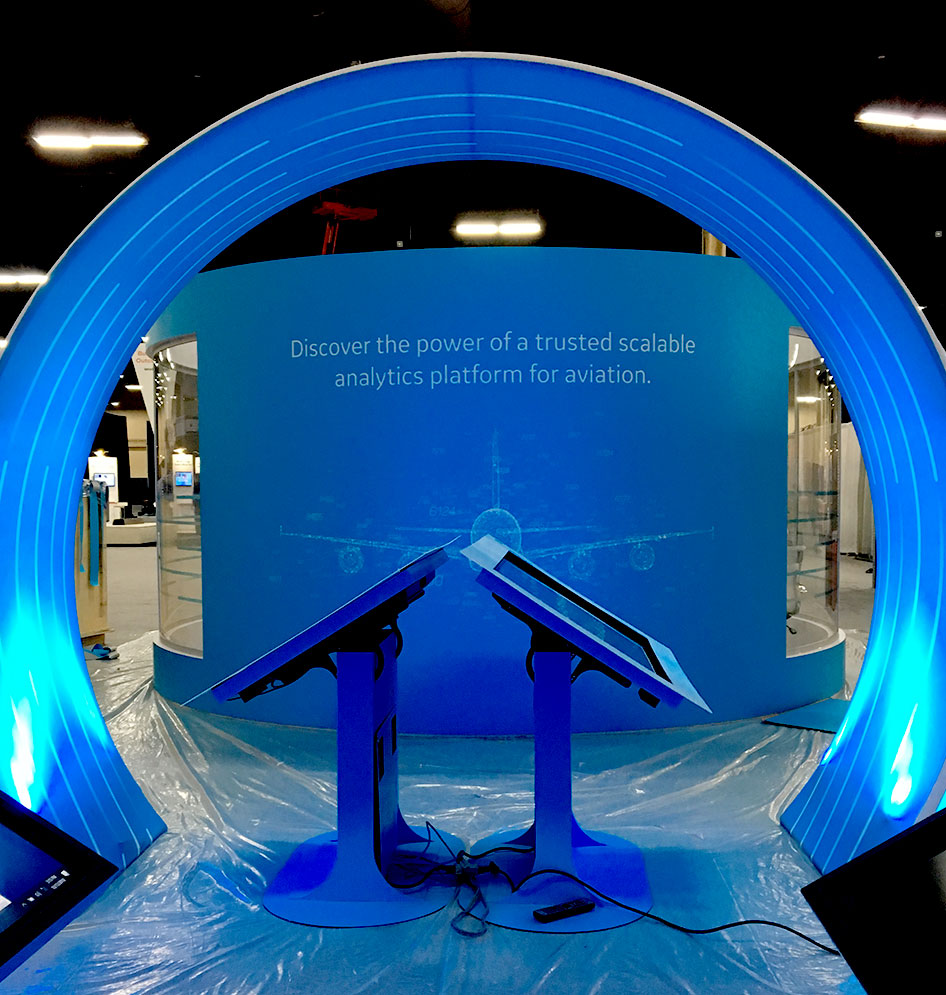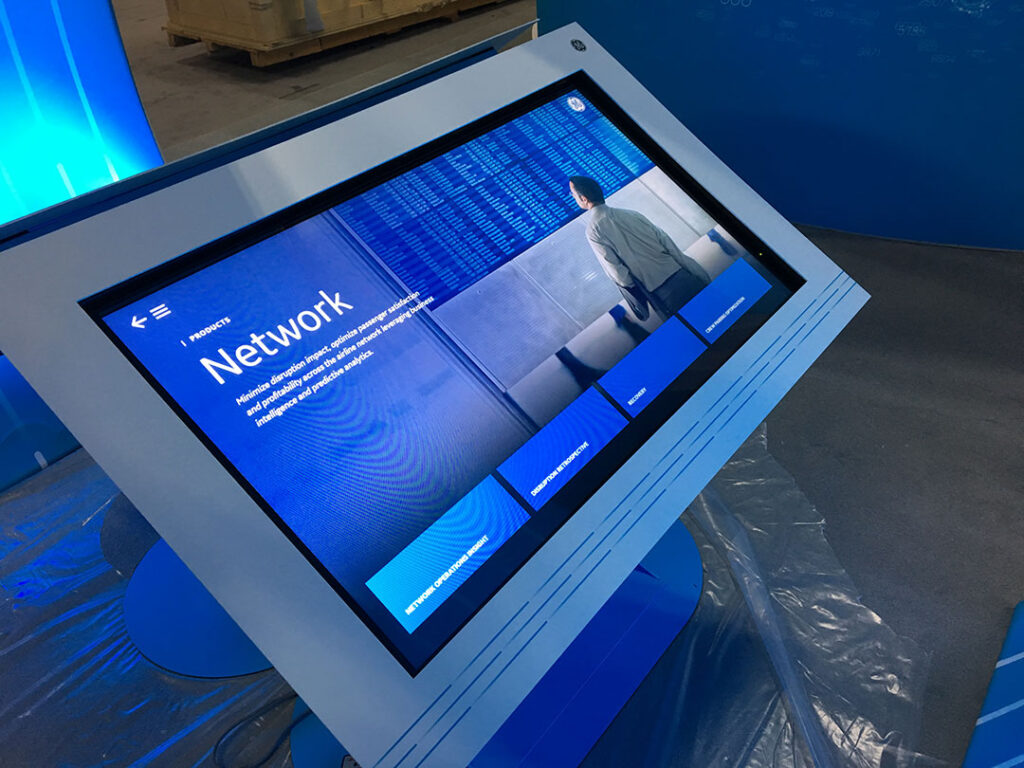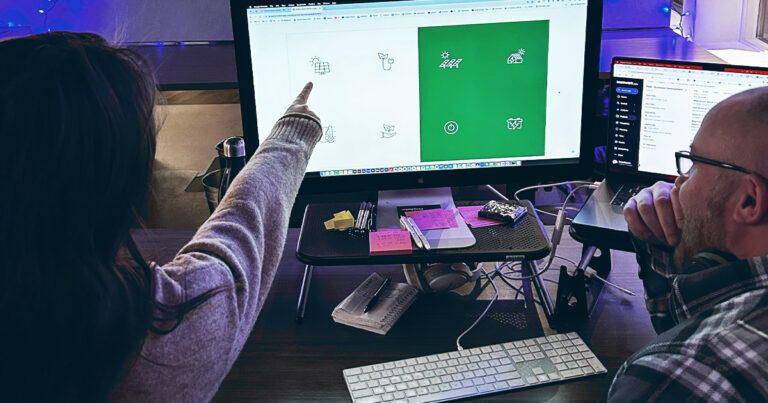Engage Audiences and Steal the Show With Visual Storytelling
If you’ve ever been to a tradeshow or conference, you know how important environmental branding design is for attracting attention and leaving attendees with a truly memorable impression of your brand.
Environmental branding allows brands to step outside their digital lairs and create an immersive experience for customers, whether it be in a store or at an event or tradeshow. In this post, we’ll define environmental branding design and the best strategies for businesses to most effectively capitalize on this marketing tactic.
What is Environmental Branding Design and Why Should Brands Care?
When brand elements are strategically incorporated into physical spaces, it can create a unique and memorable brand experience. All elements of the brand identity, from messaging to visuals, are leveraged to reinforce the brand, and what it stands for, with the goal of creating deeper and more emotional connections with audiences.
Picture an industry tradeshow. It’s packed with brands, many of which offer products and/or services in the same vertical. How do you stand out? How do you get attendees to visit your booth or spend time investigating what you have to offer?
Environmental branding design is a powerful way to achieve differentiation. A visually cohesive and engaging environment helps enhance brand recognition, create memorable experiences, and establish brand consistency across various touchpoints.
4 Key Elements of Branding That Should Be Present in Your Environmental Design
There are 4 critical components of environmental branding design to make it successful and ensure it properly conveys the brand’s messaging and visual identity.
- Colors and Patterns
Color can evoke specific emotions and associations. Utilize your brand’s color palettes and patterns to create a cohesive and recognizable environment. Consistent use of colors throughout physical spaces helps reinforce your brand and create a sense of familiarity.
- Typography and Fonts
Consistent use of fonts and typography styles on assets like signage, displays, and printed materials, helps strengthen brand recognition and reinforce your brand’s look and feel.
- Logos and Symbols
Logos and symbols are central to any brand identity. In environmental branding design, they are strategically incorporated into physical spaces, such as walls, floors, and fixtures, to reinforce brand awareness and recognition.
- Signage and Wayfinding
Help guide customers within a space using your branded elements. Signage and wayfinding elements should align with your brand’s visual identity, providing a seamless and cohesive navigation experience that reflects your brand’s personality and values.

Benefits of Environmental Branding Design
- Strengthening Brand Recognition
Consistent application of brand elements across physical spaces creates a memorable and distinctive brand identity, making it easier for customers to identify and remember your brand.
- Creating Memorable Experiences
When customers feel connected and engaged with your brand’s physical environment, they are more likely to develop positive associations and loyalty toward your brand. Plus, memorable experiences foster long-term relationships and word-of-mouth referrals.
- Fostering Emotional Connections
Intentional design choices can evoke specific emotions and forge emotional connections with customers. By aligning the physical environment with your brand’s values and messages, you can create a sense of authenticity and resonate on a deeper level.
- Establishing Brand Consistency
Don’t create doubt among your customers by being inconsistent in your branding. Ensures that the brand’s visual identity and messaging – from the tabletop sign on the booth to your business card – remain consistent across any physical space.
Strategies for Effective Visual Storytelling
To maximize the impact of environmental branding, businesses should adopt effective strategies that align with their brand objectives and target audience.
Research and Understanding the Audience
Where is your branded environment going to be and who’s going to be there? The experience you have for attendees may look and feel different at a tradeshow, which will be populated with others in your industry, versus a standalone event where you’re the only brand in your space. Understand your target audience – who are they, and what do they need to get out of your brand to walk away with a positive experience?
Integration of Branding Elements
Successful environmental branding design integrates various branding elements seamlessly. Banners, signs, booth graphics, and handouts should seamlessly blend your brand’s messaging and visual identity to effectively represent your brand.
Consistency Across Physical and Digital Spaces
We’re not being redundant here; in fact, it can be quite challenging to establish consistency for your brand in the digital and physical worlds at the same time. For example, maybe you just went through a rebrand and have a new brand identity, but you haven’t redone the website yet. You might bring business cards, handouts, and signs to a tradeshow that all reflect your new brand look and feel, but anyone visiting your website will experience the old brand look and feel. While it is exciting to share your brand’s reinvented image, it comes at the risk of an inconsistent experience with your brand.

Case Studies of Successful Environmental Branding
In these fictional scenarios, we provide examples of successful environmental branding design in very different executions, as well as insights for businesses aiming to enhance their brand experience.
Company A: Transforming Office Spaces
Company A is a leading technology firm that recently transformed its office spaces into vibrant, collaborative environments that reflect the brand’s innovative and creative culture. The strategic use of color, open layouts, and branded installations created an engaging and inspiring workplace that fosters creativity and collaboration among employees.
Company B: Creating Engaging Retail Environments
Company B is a global consumer brand that invested in environmental branding design to create immersive retail environments to catch shoppers’ attention and increase brand recognition in an ideal environment. By integrating brand elements into store layouts, signage, and displays, they enhanced the customer experience, increased purchases, and generated higher customer engagement and loyalty.
Company C: Establishing a Strong Brand Presence in Events
Company C, a lifestyle brand, leveraged environmental branding design to establish a strong brand presence at events and exhibitions, inclusive of a totally unique augmented reality photobooth that enabled attendees to see how they would look in the lifestyle brand’s product. Through the captivating AR experience coupled with consistent branding elements, Company C created memorable brand experiences that left a lasting impact on event attendees.
Future Trends in Environmental Branding Design
As events evolve, consumer demands increase, market spaces tighten, and technological options for unique installations expand, environmental branding design is advancing in lockstep. Of course, brands can attend events with the traditional booth-and-handout approach, but all businesses should keep an eye on these following trends to stay ahead of the curve.
- Technological Innovations and Digital Integration
Technological innovations, such as AR, AI, and interactive displays, are increasingly being integrated into environmental branding design. These advancements allow businesses to create dynamic and immersive brand experiences, blurring the boundaries between physical and digital realms.
- Sustainable and Eco-Friendly Approaches
On the part of both brands themselves and the events they’re attending, there is a growing emphasis on sustainability and taking an eco-friendly approach to event presence and executions. Utilizing recycled materials, energy-efficient lighting, and eco-conscious design choices not only aligns with these planet-positive values but also resonate with environmentally-conscious customers.
- Personalization and Customization
By tailoring the brand experience to individual customers’ preferences and needs, businesses can create more meaningful and memorable interactions, fostering stronger audience connections and brand loyalty.
The Power of Physical Spaces
Environmental branding design is a great way to reflect your brand’s identity and foster critical connections with both new and existing customers through unique, memorable experiences. By strategically incorporating branding elements into physical spaces, businesses can leave a powerful lasting impression on customers.
Couple those opportunities with technological integration and sustainability trends, and environmental branding design presents exciting ways for businesses to innovate and differentiate themselves in the marketplace.
FAQs About Environmental Branding Design
What is the difference between branding and environmental branding?
Environmental branding is a subset of branding that focuses on incorporating brand elements into physical spaces to create an immersive brand experience, whereas branding encompasses a broader range of activities that shape a brand’s identity, including marketing, messaging, and visual design.
Can environmental branding design be applied to online platforms?
While environmental branding design primarily focuses on physical spaces, its principles can be applied to online platforms as well. Consistency in visual identity, messaging, and user experience across digital channels contributes to a cohesive brand experience.
How can environmental branding design help improve employee morale?
A well-designed and branded physical workspace can have a positive impact on employee morale. It creates a sense of pride, fosters a collaborative and inspiring atmosphere, and reinforces the company’s values, leading to increased employee engagement and satisfaction.
Are there any limitations to environmental branding design?
Environmental branding design requires careful planning, budget considerations, and ongoing maintenance. It may not be suitable for all businesses, especially those with limited physical spaces or tight budgets. Additionally, design choices must align with the target audience and brand positioning to be effective.
How can businesses measure the effectiveness of their environmental branding design efforts?
Effectiveness can be measured through various metrics, including customer feedback, brand recognition surveys, customer engagement and loyalty metrics, and sales data. Regular evaluation and analysis of these metrics provide insights into the impact of environmental branding design on the brand’s success.


